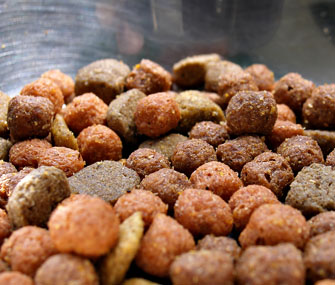1. Invest in a Nutritionally Balanced Diet
Whether it’s a veterinary nutritionist’s recipe or an off-the-shelf commercial formula recommended by your vet, stick to something that’s nutritionally balanced. (It will usually say so on the side of the bag or can.)
2. Add Moisture to Feline Food
This is currently a highly controversial topic in veterinary medicine, but one 2010 study conducted at theWaltham Center in the U.K. found that cats who were fed moistened diets — even if it was just kibble mixed with water — were more active and weighed less at the end of the study.
3. Measure, Measure, Measure

Thinkstock
This is fundamental when you’re trying to figure out how much to feed, so use a proper measuring tool — a mug isn't going to cut it if you want to get your pet's portion just right.
4. Be Consistent
It may go without saying, but you need to make sure the food you give your pet is prepared more or less the same way every time, so, if you home cook, that means being careful about preparing consistent portions. You should also be vigilant about feeding your pet the same formula and brand of food, as well as keeping tabs on the calorie counts of different formulas and brands.
5. Assess if You're Feeding Too Much or Too Little
Here’s where you need to ask your vet to point blank tell you just how fat your pet really is through a body condition score. A high body condition score (BCS) means your pet needs to lose weight.
6. Learn to Titrate
The right amount of food is almost always determined through trial and error. In other words, you may have to increase and decrease food amounts over time until you hit on the right daily portion. For example, you may start with one can of food a day, but your vet says your cat is too fat. So you reduce the food by 1/4 can a day, prompting her to lose weight. After about a month, you and your vet both think she’s getting a tad skinny, so you add back in a tablespoon a day.
7. Don't Forget That Treats Count
Treats are food, too, and they’re usually more calorically dense.
8. Factor in Exercise
Most of the above takes into account a regular amount of exercise (or lack thereof). If your pup is joggingalong with you each morning as you train for a marathon, for example, you may want to increase the amount of food that tumbles into the food bowl — temporarily, anyway.
9. Expect Age-Related Changes
As he gets older, a pet's metabolism (like our own) slows down — and that means a little less food every year. Or try switching to senior dog food, which contains less fat.
10. Keep in Mind That Every Animal Is Different
I have three dogs. The smallest one is half the size of the other two yet he eats twice as much. The moral of the story: Don't let volume sway you; each organism has a distinct metabolism that runs at its own pace.
No comments:
Post a Comment